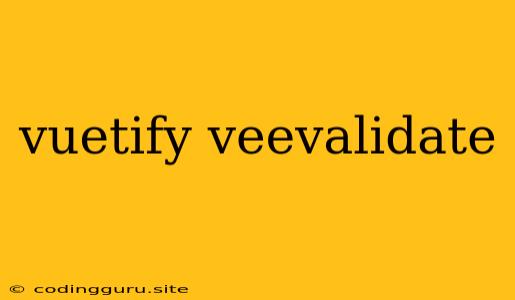Enhancing Your Vue.js Forms with Vuetify and VeeValidate: A Powerful Combination
Building robust and user-friendly forms is a crucial aspect of any web application. Vue.js, with its reactive nature and component-based architecture, provides an excellent foundation for form development. However, to elevate your form building experience, you can leverage the power of Vuetify and VeeValidate, two indispensable libraries that streamline the process and enhance the visual appeal.
Vuetify is a Material Design component framework designed specifically for Vue.js. It offers a comprehensive collection of ready-to-use components, including form elements, input fields, buttons, and more, all styled according to Google's Material Design guidelines. This ensures a consistent and aesthetically pleasing look and feel across your application.
VeeValidate, on the other hand, is a validation library built for Vue.js. It provides a declarative way to define validation rules for your form fields. With VeeValidate, you can easily implement a variety of validation checks, such as required fields, email format, numerical ranges, and custom validation logic.
Why Combine Vuetify and VeeValidate?
The combination of Vuetify and VeeValidate unlocks a powerful synergy for form development in your Vue.js applications. Here's why:
- Seamless Integration: Both libraries are designed to work harmoniously with Vue.js, providing a smooth integration experience.
- Elegant Forms: Vuetify offers visually stunning form components that adhere to Material Design principles, creating an intuitive and engaging user interface.
- Robust Validation: VeeValidate takes care of the validation logic, allowing you to define rules easily and ensure data integrity.
- Simplified Development: By handling form rendering and validation separately, you can focus on the business logic of your application.
- Improved User Experience: Validation feedback and error messages provided by VeeValidate guide users through the form completion process, reducing frustration and improving data quality.
Getting Started: Setting Up Vuetify and VeeValidate
-
Project Setup: Ensure you have a Vue.js project set up. If you don't, you can use the Vue CLI to create one:
vue create my-vuetify-veevalidate-project -
Install Vuetify: Install the Vuetify package using npm or yarn:
npm install vuetify -
Install VeeValidate: Install VeeValidate and its required dependencies:
npm install vee-validate @vee-validate/rules @vee-validate/i18n -
Configure Vuetify: Import and register Vuetify in your main Vue.js file (
main.js):import Vue from 'vue'; import App from './App.vue'; import Vuetify from 'vuetify'; import 'vuetify/dist/vuetify.min.css'; // Import Vuetify's CSS Vue.use(Vuetify); new Vue({ el: '#app', vuetify: new Vuetify(), // Create Vuetify instance components: { App }, template: '' }); -
Configure VeeValidate: Import and configure VeeValidate in your main Vue.js file:
import Vue from 'vue'; import App from './App.vue'; import { ValidationProvider, ValidationObserver } from 'vee-validate'; // Import and configure VeeValidate rules import { required, email } from '@vee-validate/rules'; // Import and configure VeeValidate I18n import { localize } from '@vee-validate/i18n'; Vue.use(ValidationProvider); Vue.use(ValidationObserver); // Register validation rules extend('required', required); extend('email', email); // Set up localization for VeeValidate localize('en', { // Use English for validation messages validation: { required: 'This field is required', email: 'Please enter a valid email address' } });
Building a Basic Form with Vuetify and VeeValidate
Let's create a simple form to illustrate how to use Vuetify and VeeValidate together:
Submit
In this example:
- We use a
<v-form>component from Vuetify to structure the form. <v-text-field>components are used for the name and email inputs.v-modelis used to bind the input values to data properties.requiredandemailvalidation rules from VeeValidate are applied to the fields.- We use a
ValidationObserverto track the overall form validity and enable/disable the submit button usingformIsValid.
Advanced Form Building with VeeValidate: Tips and Tricks
VeeValidate offers a wide range of features to enhance your form validation capabilities. Here are some advanced tips and tricks:
- Custom Validation Rules: Create your own validation rules to cater to specific business requirements.
- Conditional Validation: Apply validation rules based on conditions, such as the values of other fields.
- Validation Groups: Group validation rules together for easier management.
- Custom Error Messages: Customize error messages for a more informative user experience.
- Asynchronous Validation: Perform validation checks that involve server-side requests.
- Validation Providers: Wrap form fields within
<ValidationProvider>components to manage individual field validation. - Validation Observers: Use
<ValidationObserver>components to track overall form validity.
Conclusion
Vuetify and VeeValidate are powerful tools that empower you to create beautiful and functional forms in your Vue.js applications. Their combination offers a streamlined development process, robust validation, and an excellent user experience. By embracing the features and flexibility of these libraries, you can build forms that meet your specific needs while ensuring data integrity and user satisfaction.
